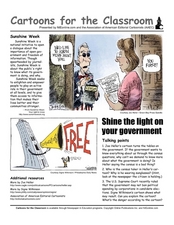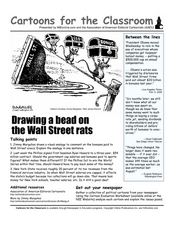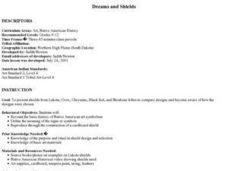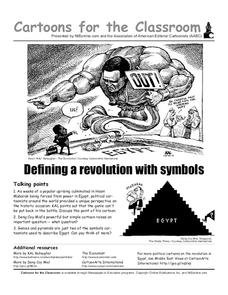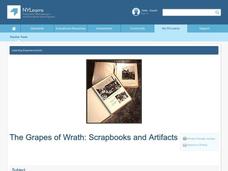Curated OER
Cartoons for the Classroom: Invasion of the Superdelegates
What are superdelegates? Use this political cartoon analysis handout to explore this informal term with your scholars. Background information gives brief context to help high schoolers examine the featured cartoon, and three talking...
Curated OER
Cartoons for the Classroom: The Climate Change Debate
Is global warming all smoke and mirrors? Find out what your scholars think with this handout, which has them analyzing two political cartoons on the topic. Background information gives context, detailing the computer hacking during the...
Curated OER
Corporate Profits vs. Jobs
Bring the Occupy Movement debate to your classroom. This political cartoon analysis offers a chance for pupils to explore their personal ideas about corporate America and current economic issues. Background information is provided to...
Curated OER
Cartoons for the Classroom: Dogging the Dems
Political cartoons add an element of fun as your scholars study current events in Washington D.C. This analysis handout uses two cartoons to bring learners into discussion about the many issues democrats have concern over as November...
Curated OER
Cartoons for the Classroom: Shine the Light on Your Government
What don't we know about our government? Explore the concept of transparency and freedom of information throught this analysis handout, in which scholars examine 2 political cartoons. Background information provides context, explaining...
PBS
The Sixties: Dylan Plugs in and Sells Out
Before Woodstock, there was Newport. Get plugged in to the social changes of the 1960s with a lesson that looks at Bob Dylan's performance at the 1965 Newport Folk Festival as a symbol of the radical changes that marked the era.
Curated OER
Cartoons for the Classrooms: Wall Street
Open up an intriguing dialogue about Wall Street controversy using political cartoons! Background information gives context, including quotes from various newspapers about compensation caps, bonuses, and the growing disenchantment with...
Curated OER
Lesson One: Flag Day
Students discuss importance and symbolism of flags to United States and its people, discuss history and meaning of American flag, identify flags of other countries, analyze symbolism of color, shape, and design, and view images of Civil...
Curated OER
Dreams and Shields
Learners study and view examples of shields from the Lakota, Crow, Cheyenne, Black Feet, and Shoshone tribes. They find the meaning of the symbols used on the shields and then make their own shields out of cardboard.
Curated OER
Flip Flop Diplomacy
Ninth graders examine the dress of diplomats. In this American Government lesson, 9th graders read an article and answer guided questions. Students participate in a quiz on the reading.
Curated OER
Totem Transformations
Students are introduced in the Humanities class, as they explore the origins of Totems in Native American folklore. In the computer lab, students read Totem stories and explore the meaning and symbolism behind the myths using various Web...
Curated OER
Make Your Own Petroglyph!
Students create their own petroglyph. In this petroglyph lesson, students study and compare various petroglyphs. They create their own petroglyph to symbolize the seasons.
Curated OER
Cartoons for the Classroom: Defining a Revolution with Symbols
In this current events worksheet, students analyze a political cartoon about the Egyptian Revolution and respond to 3 talking point questions.
Curated OER
Time Machine: Drive for the American Dream
Students view a documentary on automobiles. Americans have always been in love with automobiles. They are a definition of character, and a representation of social status. After viewing, students discuss what they saw and create an...
Curated OER
"Open Mic" - Giving Creative Expression To The Connection Between The Japanese American Internment, September 11, And Our Rights Today
Students explore the similarities of the Japanese-American experience in WWII and Arab-American experience in post-September 11 US policy. They create presentations on their reflections and express themselves through poetry, dance,...
Curated OER
Westward Expansion and the War with Mexico
Students evaluate primary sources to develop their own opinions about Westward Expansion. In this Manifest Destiny lesson, students examine and respond to questions about Gast's painting titled American Progress Students research how...
Curated OER
An Academic, Economic, Cultural, and Political Lesson Plan
Students reflect on how many board games they've played have African Americans, their culture or history incorporated within. They identify four street games and three card games that appeal to African Americans. They play the...
Curated OER
McCarthyism: 60 Years Later
Explore legendary cartoonist Herb Block's bold challenge of McCarthy-era politics through this analysis activity. Two cartoons are included, along with talking points to prompt analysis and background information to help pupils "read...
National Endowment for the Arts
Teacher's Guide: The Great Gatsby by F. Scott Fitzgerald
A 10-lesson unit takes high schoolers through a novel study of F. Scott Fitzgerald's The Great Gatsby. To start, students learn about Fitzgerald's background and gain historical context that prepares them for a reading of the book. The...
Curated OER
Sequencing of Events
Young scholars pick a time period and put events in chronological order using symbols.
Curated OER
The Grapes of Wrath: Scrapbooks and Artifacts
High schoolers complete research to enhance their reading of "The Grapes of Wrath". Using the text, they identify and locate cultural artifacts and discuss their symbolic connotations. As a class, they create a museum exhibit of the...
Curated OER
Warhol and Collaboration
Learners view images of Warhol/Basquiat collaboration and discuss them using the questions listed in the lesson. They work in groups to choose a theme or topic relating to American culture and discuss ideas about symbols that could be...
Eastconn
Learning to Analyze Political Cartoons with Lincoln as a Case Study
Discover the five main elements political cartoonists use—symbolism, captioning and labels, analogy, irony, and exaggeration—to convey their point of view.
Curated OER
Treaty of Versailles
Students describe the purposes of the Treaty of Versailles. In groups, they analyze the causes and effects of the treaty and discuss why the Americans were so against it. They note ideas for and against its ratification and they make...
Other popular searches
- Native American Symbols
- American Symbols Alphabet
- American Symbols Grade 1
- American Symbols of Freedom
- American Symbols and Figures
- American Symbols Lessons
- History American Symbols
- Art Native American Symbols
- Symbols American Flag
- American Symbols Activity
- Native American Symbols Vest
- American Symbols Unit




